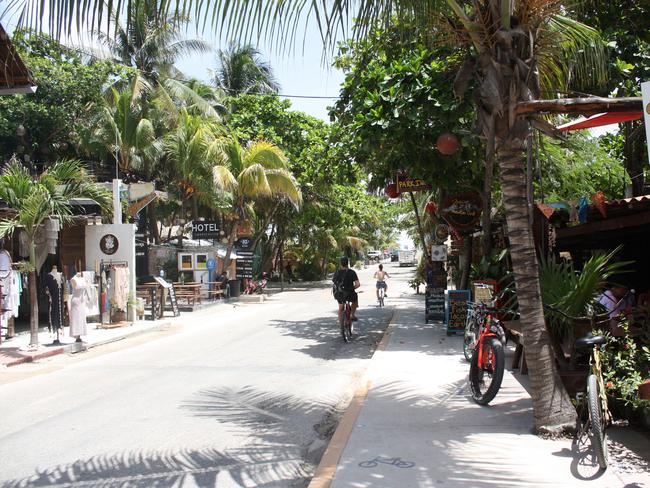What no one told me about visiting Tulum, Mexico
IT’S the destination on everyone’s lips right now thanks to its white sand beaches, new age vibe and jungle shrouded restaurants but this Aussie never expected this.

‘WHAT is that awful smell?’ I wondered.
I was walking into beachside restaurant La Zebra in Tulum, Mexico for lunch and had just gotten a whiff of a strong fishy stench. A few steps further and I saw it. There, in the distance on the white sand, were piles and piles of thigh-high seaweed. Tulum’s famed clear-to-cyan water was a murky grey. Despite the glorious weather, not a single swimmer was in sight.
As it turns out, the seaweed invasion plagues the hippy-luxe town for a few months of every year. Whether it’s a result of global warming or just a natural occurrence, for someone as eager to be hitting the beach as I was, it was a disappointing discovery. And one I wished I’d known before heading over.
It was the first of many surprises I would have in Tulum. Photos of the hippy-luxe town are plastered all over Instagram and at the top of ‘best of’ travel lists. Before heading over, I thought I knew it well. I was wrong.
WHAT NO ONE TOLD ME ABOUT BALI
I FOUND AUSTRALIA’S MOST UNDERRATED ISLAND
40C TACOS: WHY THIS SPOT IS YOUR NEW NO.1
I NEVER EXPECTED THIS IN NORTH KOREA

THERE AREN’T JUST A FEW CENOTES, THERE ARE THOUSANDS
My first revelation about Tulum came before I’d even arrived. Sure, the town’s eco-resorts and seaside ruins had looked impressive, but it was the cenotes, limestone sinkholes, that I’d been most excited about.
“Four thousand,” my guidebook had read. That was the number of them of them in the Riviera Maya. Not two or three as I’d assumed. More than 4,000.
And when I got to Tulum, it got even better. I’d assumed that like most every other natural tourist attraction, the cenotes would be miles out of town and requiring of day trips. Arriving into town on their local bus, I could see signs along the road indicating their entrances.
Just within 15 minutes drive of Tulum’s downtown, there were dozens — some big and crowded like Grand Cenote and Dos Ojos, others just small, water-filled holes to jump in.

THERE ARE TWO TOTALLY DIFFERENT AREAS
After spending the first few days getting around by bike in Tulum’s inland downtown pueblo, my friend arrived with a rental car. We were staying in the other part of town: the hotel zone.
Fifteen minutes along a road winding past the beach and we’d reached it. Though only a short distance from downtown, it was another scene entirely. While downtown’s streets were lined with market stalls, hole-in-the-wall Mexican restaurants and budget accommodation, the hotel zone, which hugged the coastline, had trendy restaurants, organic clothing-selling boutiques and ritzy eco-resorts.
I spent the remainder of my time there, and wished I’d known how different, and in my opinion, better it was than downtown from the start. Yes, it was far pricier, but its single winding road lined with treehouse hotels and restaurants carved into jungle was unlike any other place I’d been before.

IT’S MUCH MORE THAN A BEACH TOWN
Having grown up in the US, I’d visited Cancun countless times. My holidays there were spent exclusively at the all-inclusive resort. In later years, late nights at mammoth nightclubs were added to the routine.
With Tulum only 90 minutes south of Cancun, naturally, I’d expected a holiday there to be similar. And while the guidebook had quickly corrected that assumption, upon arrival in Tulum, I was gobsmacked by the activities and sights there were to do and visit.
There was cenote hopping of course, but there was also the chance to visit the ancient Mayan ruins at Tulum, Coba and Chichen Itza, explore caves or swim with whale sharks. There were acclaimed restaurants like Hartwood and Safari to try and nightclubs like Gitano and Papaya Playa Project to check out. After two weeks there, I felt like I’d only scratched the surface — there was that much to do.

IT’S NOT AS CHEAP AS YOU’D THINK
I’d thought Tulum would be cheap. After all, Mexico for the most part is an extremely affordable place to travel with large meals from taco shacks generally costing less than $2AUD.
Unfortunately for my bank account however that wasn’t the case. Restaurants in the hotel zone averaged $25AUD for mains. More than a few hotels in the area charged upwards of $700AUD a night for standard rooms.
While prices downtown were certainly more down-to-earth, they too were still pricier than I’d thought. Even visits to the cenotes were $10 and $50 a pop, which added up quickly.
But though my time in Tulum did prove more expensive than I’d anticipated, it had been more than worth it. The incredible photos I’d seen of it hadn’t done it justice. Its natural setting was more unlike anywhere else in the world, and its town more was more creative. Armed with my insights however, my next trip there will be even better.

Have you been surprised by a holiday destination? Email us at escape@news.com.au



